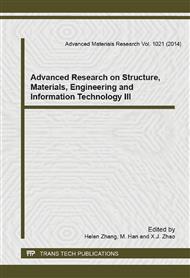p.105
p.111
p.115
p.119
p.123
p.128
p.140
p.144
p.148
Experimental Research of Recycled Tires-Asphalt Sands Base Isolation Device for Low-Raise Masonry Structure under Vibrating Load
Abstract:
In the program, dynamic experiments were carried out on two scale models of the recycled tires-asphalt sands (RT-AS) base isolation device. The device consists of recycled tires and the mixture of asphalt and sand at the ratio of 3:1 in weight. Since the tires consists of rubber, the elastic deformation can consume energy, and for asphalt-sands , the friction between sands and the elastic deformation of the mixture of asphalt-sands can also consume energy, RT-AS base isolation device can help the superstructure consume part of energy from seismic wave. In this way, the device can not only can protect environment through recycling worn tires, but isolate the structure from the shaking ground and decrease the damage to the superstructure. To investigate the effectiveness of a new seismic isolation device (RT-AS),two scale models of one-storied masonry structure were built up according to the ratio of 1:12. During the experiment, The WE-Z30 Precise Mini-seismic Shaking Table System was employed with the seismic wave of the earthquake in Wen Chuan in 2008 according to the record of NS direction of Shifang seismographic observatory, The experiment was conducted under three level of vibrating load using vibration exciter, and the positive effect of RT-AS device on reducing the acceleration response of the building was discussed.
Info:
Periodical:
Pages:
123-127
Citation:
Online since:
August 2014
Authors:
Price:
Сopyright:
© 2014 Trans Tech Publications Ltd. All Rights Reserved
Share:
Citation:


